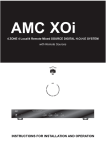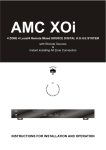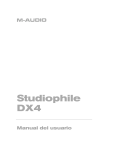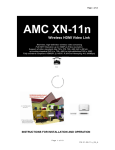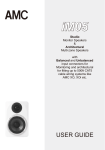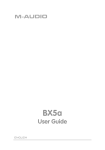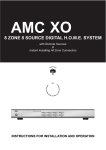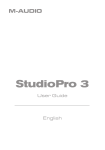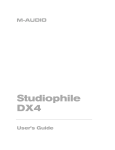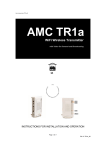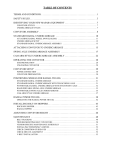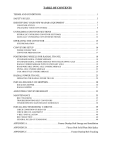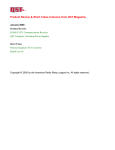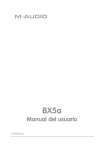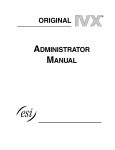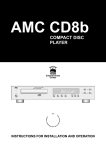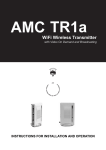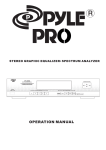Download AMC T7a USER MANUAL
Transcript
AMC T7a STEREO TUNER AMCTM HOME Entertainment Center INSTRUCTIONS FOR INSTALLATION AND OPERATION RISK OF ELECTRIC SHOCK DO NOT OPEN RISQUE DE CHOC ELECTRIQUE N OUVRIR PAS RIE SGO DE ELECTROCHOQUE NO ABRIR LA TAPA CAUTION: TO REDUCE THE RISK OF ELECTRIC SHOCK, DO NOT REMOVE COVER (OR BACK). NO USER-SERVICEABLE PARTS INSIDE. REFER SERVICING TO QUALIFIED AFIN DEVITER UN CHOC ELECTRIQUE ET LES CONSEQUENCES GRAVES QUI POURRAIENT EN RESULTER, TENTEZ PAS D'OUVRIR L'APPAREIL ET DE TOUCHER AUX COMPOSANTS INTERNES SANS LA PRESENCE D'UNE PARA REDUCIR EL RIESGO DE SACUDIDAS ELECTRICAS, NO DEBERA QUITARSE LA TAPA (NI PARTE POSTERIOR). CONSULTESE AL PERSONAL CAPACITADO PARA LAS WARNING: TO PREVENT FIRE OR ELECTRIC SHOCK, DO NOT EXPOSE THIS APPLIANCE TO RAIN OR MOISTURE. ADVERTENICIA: PARA EVITAR EL RIESGO DE INCENDIO O SACUDIDA ELECTRICA, NO DEBERA CAUTION: TO PREVENT ELECTRIC SHOCK DO NOT USE THIS (POLARISED) PLUG WITH AN EXTENSION CORD, RECEPTACLE OR OTHER OUTLET UNLESS THE BLADES CAN BE FULLY INSERTED TO PREVENT BLADE EXPOSURE. ATTENTION: POUR PREVENIR LES CHOCS ELECTRIQUES NE PAS UTILISER CETTE FICHE POLARISEE AVEC UN PROLONGATEUR. UNE PRISE DE COURANT OU UNE AUTRE SORTIE DE COURANT, SAUF SILES LAMES PEUVENT ETRE INSEREES A FOND SANS EN LAISSER AUCuNE PARTIE FOND SANS EN LAISSER AUCUNE PARTIE A DECOUVERT. PRECAUCION: PARA EVITAR SACUDIDAS ELECTRICAS, NO DEBERA UTILIZARSE ESTA CLAVIJA POLARIZADA CON UN CORDON DE PROLONGACION, RECEPTACULO U OTRO TIPO DE SALIDA A MENOS QUE SE HAYAN INSERTASO COMPLETAMENTE LAS LENGšETAS PARA EVITAR SU NOTE: Some AMC products are equipped with dual or multi-voltage transformers (which is indicated on the back panel). If you wish to change the voltage, please bring your unit to an authorised AMC service technician for internal conversion. ATTENTION: Quelques pi ces AMC sont munies de transformateurs double ou multi-voltage (indiqu au panneau arri re). Si vous voulez changer le voltage, veuillez apporter votre appareil au fournisseur de AMC pour le transformer. ZUR BEACHTUNG: Einige AMC Ger te sind mit Umschaltern f r unterschiedliche Netzspannungern ausger stet (Ein Vermerk auf der R ckseiteweistdarauf hin). Die Anpassung, wenn notwendig, mu von einem qualifizieren Techniker in einer AMC Servicestation vorgenommenwerden. NOTA: Ciertos componentes de AMC est n dotados de transformadores de doble tensi n o de varias tensiones (Io que se indica en el panel posterior). Si se desea cambiar la tensi n, s rvanse llevar el aparato a NOTE TO CATV systems installer: This reminder is provided to call the CATV system installer's attention to Article 820-22 of the NEC that provides guidelines for proper grounding and, in particular, specifies that the cable ground shall be connected to the grounding system of the building, as close to the point of cable entry as practical. NOTA PARA EL INSTALADOR DE ANTENAS DE TELEVISION COLECTIVAS: La presente advertencia se provee para llamar la atenci n del instalador al Art culo 820-22 de NEC (C rdigo El ctrico Nacional) donde se facilitan las directrices para la pertinente puesta a tierra y que especifica en particular que el condutor a tierra del cable debe connectarse al sistema de conexi n a tierra del edificio, lo m s proximo posible al punto de entrada The lightning flash with arrowhead, within an equilateral triangle, is intended to alert the user of the presence of uninsulated" dangerous voltage" within the product's enclosure; that may be of sufficient magnitude to constitute a risk of electric shock to persons. The exclamation point within an equilateral triangle is intended to alert the user of the presence of important operating and maintenance (servicing) instructions in the literature accompanying the appliance. APPLICATION AND FEATURE LIST Features of the AMCmodelT7a * The AMC model T7a was designed to meet professional quality standards for receiving FM or AM programs. * Components of the highest grade are used throughout with critical ones selected for the best sound performance, such as double-sided and thru-hole plated PCB for the best stability from RF through IF to audio. * It is simple and easy to use, and offer a superb audiophile quality performance at a very reasonable price. * 30 stations (FM or AM) can be entered in the preset mode. They are stored in a non volatile memory which allows the preset stations to remain in memory for more than two weeks even if the unit is unplugged from the mains supply. * In case of weak stations where the background noise becomes annoying and spoils the listener's enjoyment of the program, there provides a MONO button on T7a to lock the tuner in themonomodetoobtainconsistently quieter and cleaner sound. * Its simple circuit topology gives the unit noise free and low distortion performance. * Provides two options to upgrade the unit: (1) RDS module: To offer the convenience and benefits of RDS (Radio Data System) but without superfluous and confusing buttons. (2) Digital output module: To have digital output from tuner in order to be able to make digital recording through AMC ADC with digital pre-amp structure. 2 REAR PANEL CONNECTIONS/FRONT PANEL CONTROLS REAR PANEL 2 3 5 4 1 4. OUTPUT JACKS 5. DIGITAL OUTPUT "(OPTION)" 1. AC LINE CORD 2. FM ANTENNA TERMINAL 3. AM ANTENNA TERMINAL FRONT PANEL 8 9 1 10 11 2 3 1. POWER SWITCH AND POWER INDICATOR 2. STATION PRESET 3. MEMORY 4. AM/FM 5. MONO 4 5 6. AUTO 7. TUNING 8. TEXT 9. TIME 10. PROGRAM 11. TYPE 3 6 7 REAR PANEL CONNECTIONS station you can rotate the antenna for best reception. (2) A more elaborate rabbit-ears indoor TV antenna with a tuning switch. This type of antenna does NOT have greater sensitivity than the simpler rabbit-ears unit, so if your problem is that the signals you want to receive are weak, then an outdoor antenna is the only effective solution. But in cities and in large buildings where signals are strong but are contaminated by reflected "multipath" signals that interfere with good reception, the tuning switch on an elaborate indoor antenna may improve reception by reducing the interference. (3) An electrically tuned indoor antenna. Again, such antennas usually do not provide any advantage over the simplest type of "rabbit-ears" unit for receiving weak signals. But where strong signals are contaminated with interference, the antenna's aiming and tuning controls can reject the interference and yield cleaner reception. (4) An outdoor antenna. Even the finest indoor antenna, no matter how elaborate, cannot fully exploit the capabilities of a good FM tuner. For the lowest noise, minimum distortion, and largest choice of wellreceived broadcasts, an outdoor antenna is the best complement to a fine tuner. A roofmounted antenna has three fundamental advantages. First, its large size yields better sensitivity (pulling in a stronger signal form the desired station) and a narrower directional pattern for more effective rejection of multipath reflections arriving form other directions. Second, its location on a roof or tall mast places it above many sources of interference such as passing cars and buses, other buildings, etc. Third, the strength of received FM signals is directly proportional to the height of any antenna above the ground. If you already have an outdoor television antenna, using a splitter to extract FM signals from it may produce excellent results. However, many TV antennas are 1. AC LINE CORD Plug the AC line cord into a nearby wall outlet that provides the correct AC power line voltage, or into an unswitched convenience outlet on any AMC product. 2. FM ANTENNA TERMINAL An antenna must be connected to the tuner for effective receipt of stereo FM broadcasts. A ribbon-wire "folded dipole" antenna is included to get you started. When you stretch out the ribbon-wire antenna you will note that it is the form of a T. The "crossbar" portion of the T should be stretched out horizontally and tacked in place on a wall, on the back of a cabinet, or on the floor. The "vertical" section of the T goes to the 75 ohm FM antenna terminal through 300 ohm to 75 ohm matching transformer included in accessory package. In view of the exceptional sensitivity of AMC tuner circuits, you may find the ribbon-wire dipole antenna is all you need for receipt of strong local stations. But it is not very efficient at rejecting "multipath" and other forms of FM interference, and it cannot be easily rotated to optimize its pickup pattern for best reception of stations in different directions. The recommended options, in order of increasing cost, are as follows: (1) A basic "rabbit-ears" indoor TV antenna without auxiliary coils or tuning switches. Electrically, such an antenna is just another dipole (similar to the ribbon-wire antenna) with its tuned elements made of solid metal, but with the advantage of being able to be rotated. Stretch out each of its two arms to a length of 30 inches (75cm), and orient them horizontally or at a shallow angle less than 45 degrees upward. The ribbon wire emerging from the antenna's base should be connected to the tuner's 75 ohm FM antenna terminal through 300 ohm 75 ohm matching transformer in place of the supplied ribbon-wire antenna. Now, for each station in tune, after you tune the 4 effectiveness of a longwire antenna will be improved by connecting a second wire from the Ground (G) terminal to a true earthground, i.e. a copperplated rod driven several feet into earth. A substitute electrical ground may also improve effectiveness: a coldwater pipe, a seam radiator, or the third hole of modern electrical wall socket. potential interference with TV signals at nearby frequencies (channel 6 in the U.S.). You may be able to use a splitter to extract FM signals from an apartment building's master TV antenna system, but usually this yields poor results because many master antenna systems have "traps" to stop FM signals. The best choice is a directional FM-only antenna, mounted as high above ground as is practical and separated by at least two meters (7 feet) from other antennas, vertically and horizontally. If desired stations are located in different directions (more than 90 degrees apart), the antenna should be mounted on a rotor for aiming. Use shielded leading cable rather than plain "twinlead" wire, both to minimize interference and to preserve strong signals during years of weathering. The cable may be either 75ohm coaxial or shielded 300ohm type. Disconnect any indoor antenna before connecting the cable form the outdoor antenna. If you install an outdoor antenna yourself, observe these important CAUTIONS: a. Do not mount the antenna close to electric power lines. Plan the installation so that the antenna mast cannot accidentally touch power lines, either while you are installing it or later. b. Include a lightning arrester in the installation, to protect both yourself and the tuner circuit from potential danger during electrical storms. 4. OUTPUT JACKS Connect a stereo patch cord from the Left and Right output jacks to the corresponding Tuner input jacks on your amplifier. 5. DIGITAL OUTPUTS (OPTION) This is an option model for T7a. If your AMC T7a has incorporated with Digital Output Module the unit will be available with digital output in two types of jacks (RCA Jack and Toslink Jack). For details please check with AMC dealer/distributor in your country. 3. AM ANTENNA TERMINALS Since the tuner is equipped with loop antenna, no external antenna will be needed for satisfactory reception of most local broadcasting stations. But if you wish to improve reception of distant AM stations, attach a longwire outdoor antenna to the AM terminal. As its name implies, a "longwire" antenna is a simple, straight wire whose length may be anything from a few feet up to about 100 feet (30 meters), mounted parallel to the earth and as high as convenient. In some cases the 5 FRONT PANEL CONTROLS other stations that you want to store in the remaining presets. Incidentally, if you make a mistake or change your mind, it is not necessary to reprogram all presets in sequence. You can reprogram any preset simply by tuning to the desired frequency, press MEMORY, and pressing the preset # that you want to reprogram. After you finish programming the presets, you may wish to post your list of stations and associated preset numbers nearby for reference. CAUTION: in day-to-day operation be careful not to press the MEMORY button by accident. Doing so will activate the MEMORY mode, and if you then press any of the preset buttons you will unintentionally reprogram that preset. You would then have to manually retune to the station you wanted, and reprogram it into the preset. If you press MEMORY accidentally, you may wait ten seconds for the MEMORY mode to disengage. Or you can immediately force the tuner out of the MEMORY mode, in either of two ways: switch to the other tuning band (e. g. from FM to AM and back), or tap tuning buttons to change the tuned frequency. 1. POWER SWITCH The AMC T7a is turned on by pressing the power switch. The small indicator above the switch will glow green. 2. STATION PRESETS You can store the frequencies of thirty favorite stations (FM and AM), in these presets, using the MEMORY button. Then, to tune those stations from day to day, just press the appropriate presets buttons. The presets preserve their frequency assignments when the power is switched off, or when the AC line cord is unplugged, for a period of at least two weeks. Thus you can rearrange your stereo system, or move the equipment from room to room, without losing the preset frequencies. But if you leave the power off for a month or more, you may have to reprogram the tuning presets. 3. MEMORY This button engages the Memory enter mode. Use this mode to enter the frequencies of your favorite stations in the thirty presets (FM and AM). The procedure is as follows. (1) Decide which station you want to assign to each preset. (2) Select the FM or AM band, as appropriate. Using the Tuning control, manually tune to the first station on your list. Check the centertune indicator to be sure that you have tuned precisely to the center of the station's broadcast channel. Press the MEMORY button, then press Preset #01 to store the first station in the tuner's memory. (NOTE: After you press MEMORY, you will have approximately five seconds to store a station in one of the presets. After that interval, the MEMORY mode will automatically deactivate). (3) Tune to the second station on your list. Press the MEMORY button and, within ten seconds, press Preset #02 to store the second station. (4) Tune to the third station on your list, press MEMORY and press Preset #03 to store the station. Continue in this manner with any 4. AM/FM This button switches between the two tuning bands: FM or AM. The digital tuning display shows the tuned frequency in MHz (for FM) or KHz (for AM). The tuning circuit has a "last station selected" memory. When you switch between tuning to bands, the circuit automatically retunes to the last station that you tuned to when you previously used that band. 5. MONO The MONO button disables the stereo FM circuits in the tuner. Normally the tuner receives monophonic FM transmissions in mono and automatically switches on its multiplex decoding circuits when a stereo FM broadcast is received (as shown by the STEREO indicator). But when a very weak FM station signal is received, it may be excessively noisy because of the multiplex encoding technique used for stereo 6 shift up or down by this increment, as shown on the digital frequency display. To tune a broadcast signal, press continuously on either TUNING button till the tuned frequency is close to the desired broadcast frequency. Then finetune in small increments by tapping the Tuning buttons. If you know the exact frequency of the broadcast station, simply tune to that frequency. If you don't know the exact frequency, tune to the vicinity of the correct frequency and then observe the Tuning indicators while finetuning to obtain maximum signal strength. On FM, finetune till the centertune indicator is illuminated. order to obtain consistently quieter and cleaner sound. Remember to disengage the MONO button when you retune to a stronger signal. As long as the MONO button is engaged, no broadcasts can be received in stereo. 6. AUTO When the AUTO button is engaged, a red LED on the display will be lit, otherwise the unit is in MANUAL mode. In AUTO mode, the tuner scans is in a station-by-station mode rather than in small frequency increments. When the Tuning buttons is tapped, the tuner scans rapidly up or down in frequency and automatically stops at the next station whose signal is strong enough for good reception. A muting circuit automatically silences the output during the scan, till the tuning circuits lock onto a station. The MANUAL tuning mode partially overrides the scan muting. In this mode all stations (and the interstation noise) remain audible at a reduced volume level while the tuning is being scanned up or down in frequency. If you want to search for very weak signals, or if you need to fine tune away from the center of a station's broadcast channel in order to cure an interference problem, use the manual tuning mode. 8. TEXT When the TEXT button is pressed, a repeated textual message will be scrolled through the display. If the selected station is not transmitting a TEXT message, "NO TEXT" will appear on the display. 9. TIME When the TIME button is pressed, the time is displayed. The first two characters on the left hand side of the display will indicate either AM or PM, followed by the time. If the selected station is not transmitting a time signal, "NO CLOCK" will appear on the display. 10. PROGRAM When the PROGRAM button is pressed, the selected station name will appear on the display. If the selected station is not transmitting the station name, "NO NAME" will appear on the display. 7. TUNING The TUNING controls are two buttons that allow you to tune up and down the AM of FM radio spectrum. Press the right-hand button to tune toward higher frequencies or the lefthand button to tune toward lower frequencies. When the TUNING buttons are pressed momentarily, the tuned frequency shifts up or down by one step, unless the AUTO mode has been engaged. (If AUTO is engaged the tuner will scan in a station-bystation mode rather than in small tuning steps.) In North America the size of the minimum tuning step is 10KHz on the AM band and 200KHz on the FM band. In Europe and elsewhere the tuning step is 9KHz on AM and 50KHz on FM. Each time the TUNING buttons are tapped, the tuned frequency will 11. TYPE When the TYPE button in pressed, the type of program material transmitted by the selected station will be displayed, e.g. News, Classic, Pop, Sport etc. If the selected station is not transmitting TYPE information, "NONE" will appear on the display. Notes: When your T7a is not installed with RDS module, you will not find these RDS functions that are described from item (8) to (11) on your unit. For details to upgrade your 7 REMOTE CONTROL MEMORY 1 2 3 4 5 6 7 8 9 0 AM/FM SCAN AM/FM PROGRAM TEXT TAPE AMC PRESET RC-006 A wireless remote control is provided with your T7a enabling you to operate from the comfort of your chair. For reliable operation there should be a clear line-of-sight path from the remote control to the front of the tuner. Most buttons on the remote control produce the same effect as the corresponding button on the front panel of the tuner. To understand these functions please refer to relevant sections. However, the handset is also equipped with two functions (SCAN and PRESET) that are not found on front panel. The operations of these functions are described as follows: SCAN The SCAN has two buttons that allow you to tune up and down the AM of FM radio spectrum. Press the ' ' button to tune toward higher frequencies or ' ' button to tune toward lower frequencies. When the SCAN buttons are pressed momentarily (<0.5 second), the tuned frequency shifts up or down by one step. When the SCAN buttons are pressed and held more than 0.5 second, the tuner will scan in a station-by-station mode rather than in small tuning steps. PRESET Once the frequencies of favorite stations (up to 30 in either FM or AM) have been stored in this unit. To see how to set upmemory stations please refer toMEMORY description. Then, just press the PRESET buttons and the stations in the memory of the unit can be easily 8 SPECIFICATIONS FM TUNER SECTION Input Sensitivity MONO 30 dB THD+N.......................................11.3 dBf (1.0 uV/75 ohm) MONO 50 dB S/N................................................15 dBf (1.5 uV/75 ohm) STEREO 50 dB S/N.............................................37 dBf (20 uV/75 ohm) STEREO 60 dB S/N.............................................47 dBf (60 uV/75 ohm) Capture Ratio (45 and 65 dBf)...............................................................................<1.5 dB AM Rejection (45 and 65 dBf).................................................................................>60 dB Selectivity ALTERNATE CHANNEL.........................................................................65 dB Image Rejection.......................................................................................................80 dB RF Intermodulation..................................................................................................60 dB IF Rejection..............................................................................................................90 dB Subcarrier Suppression (19 and 38 kHz)..................................................................60 dB THD at 100% Modulation MONO 1 kHz..................................................................0.08% 100 Hz6 kHz....................................................................0.2% STEREO 1 kHz..................................................................0.08% 100 Hz6 kHz....................................................................0.3% Signal/Noise Ratio MONO...........................................................................>78 dB (at 65 dNf, 1HF weighted) STEREO.......................................................................>74 dB Frequency Response 30 Hz15 kHz................................................................+/0.5 dB Stereo Separation 1 kHz...............................................................................50 dB 30 Hz10 kHz.......................................................................35 dB Output Level.........................................................................................................530 mV AM TUNER SECTION Useable Sensitivity...................................................................................................10 uV Selectivity.................................................................................................................30 dB Image Rejection.......................................................................................................45 dB IF Rejection..............................................................................................................35 dB Signal/Noise Ratio (30% modulation, 50mV input)....................................................45 dB THD..........................................................................................................................0.5% Output Level..........................................................................................................125mV Weltronics Corp. reserved the right to improve its products at any time. Specifications are 9 SAFETY INSTRUCTION 16. DAMAGE REQUIRING SERVICE 1. READ INSTRUCTIONS All the safety and operating instructions should be read before the appliance is operated. 2. RETAIN INSTRUCTIONS The safety and operating instructions should be retained for future reference. 3. HEED WARNINGS All warnings on the appliance and in the operating instructions should be adhered to. 4. FOLLOW INSTRUCTIONS All operating and use instructions should be followed. The appliance should not be used near water - for example, near a bathtub, washbowl, kitchen sink, laundry tub, in a wet basement, or near a swimming pool, etc. 6. CARTS AND STANDS The appliance should be used only with a cart or stand that is recommended by themanufacturer. 7. WALL OR CEILING MOUNTING 17. POWER LINES (APPLIES TO TUNER AND RECEIVERS ONLY) An outdoor antenna should be located away from power lines. 5. WATER AND MOISTURE 6A. An appliance and cart combination should be moved with care. Quick stops, excessive force, and uneven surfaces may cause the appliance and cart combination to overturn. The appliance should be serviced by qualified service personnel when: a) The power-supply cord or the plug has been damaged; or b) Objects have fallen, or liquid has been spilled into the appliance; or c) The appliance has been exposed to rain; or d) The appliance does not appear to operate normally or exhibits a marked change in performance; or e) The appliance has been dropped, or the enclosure is damaged. PORTABLE CART WARNING S3125A This equipment is not designed for use mounted on a wall or a ceiling. 8. VENTILATION The appliance should be situated so that its location or position does not interfere with its proper ventilation. For example, the appliance should not be situated on a bed, sofa, rug, or similar surface that may block the ventilation openings, or placed in a built-in installation, such as bookcase or cabinet that may impede the flow of air through the ventilation openings. 9. HEAT The appliance should be situated away from heat sources such as radiators, heat registers, stoves, or other appliances (including amplifiers) that produce heat. 18. OUTDOOR ANTENNA GROUNDING (APPLIES TO TUNER AND RECEIVERS ONLY) If an outside antenna is connected to the receiver, be sure the antenna system is grounded so as to provide some protection against voltage surges and built up static charges. Section 810 of the National Electrical Code, ANSI/NFPA No. 70-1984, provides information with respect to proper grounding of the mast and supporting structure, grounding of the lead-in wire to an antenna discharge unit, size of grounding conductors, location of antenna-discharge unit, connection to grounding electrodes, and requirements for the grounding electrode. See Figure. a) Use No. 10 AWG (5.3 mm2) copper, No. 8 AWG (8.4 mm2) aluminum, No. 17 AWG (1.0 mm2) copper-clad steel or bronze wire, or larger, as a ground wire. b) Secure antenna lead-in and ground wires to house with stand-off insulators spaced from 4-6 feet (1.22-1.83 m) apart. c) Mount antenna discharge unit as close as possible to where lead-in enters house. d) Use jumper wire not smaller than No.6 AWG (13.3 mm2) copper, or the equivalent, when a separate antennagrounding electrode is used. See NEC Section 810-21(j). Antenna Grounding According to the National Electrical Code 10. POWER SOURCES The appliance should be connected to a power supply only of the type described in the operating instructions or as marked on the appliance. Antenna Lead In Wire 11. POWER-CORD PROTECTION Power-supply cords should be routed so that they are not likely to be walked on or pinched by items placed upon or against them, paying particular attention to cords at plugs, convenience receptacles, and the point where they exit from the appliance 12. CLEANING The appliance should be cleaned only as recommended by themanufacturer. Ground Clamp Electric Service Equipment The power cord of the appliance should be unplugged from the outlet when left unused for a long period of time. Power Service Grounding Electrode System (NEC Art 250 Part H) 14. OBJECT AND LIQUID ENTRY 15. SERVICING The user should not attempt to service the appliance beyond that described in the operating instructions. All other servicing should be referred to qualified service personnel. Grounding Conductors (NEC Section 810.21) Ground Clamps 13. NON USE PERIODS Care should be taken so that objects do not fall and liquids are not spilled into the enclosure through openings. Antenna Discharge Unit (NEC Section 810.20) National Electrical Code Available from Library, book stores, or National Fire Protection Association (Batterymarch Park, Quincy. MA 02269). AMC 21-3004 AMC Web: http://www.amchome.com PN: 21-4133












